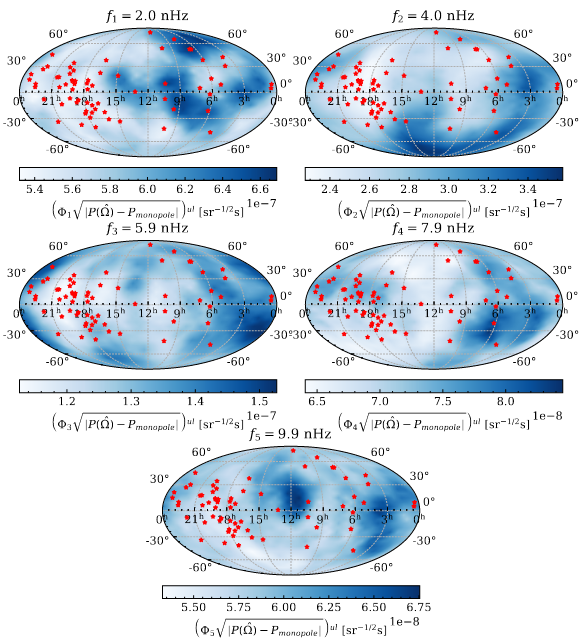
The first galaxies were small and very irregularly shaped. We believe that larger and more structured galaxies like the Milky Way formed through the mergers or these smaller and less structured galaxies. Our experiment will reveal unique insights into the physical processes governing this process. Illustration: Olena Shmahalo
The evidence for a gravitational wave background (GWB) reported in NG15gwb and other pulsar timing array (PTA) publications makes the assumption that the GWB is isotropic, i.e. the background looks the same in all directions on the sky.
This is a robust assumption when our main goal is to make the first detection of the GWB. However, if the GWB is produced by a population of inspiraling supermassive black hole binary (SMBHB) systems, then the GWB will be different in different directions on the sky, depending on how these systems are distributed in the local Universe. This effect is known as anisotropy, and in this analysis, we search for evidence of anisotropy in the GWB reported in the NANOGrav 15 yr dataset.

Reconstructed frequency-resolved sky maps showing the 95% upper limit on deviations away from isotropy in GWB power for the lowest five frequency bins from the NANOGrav 15 yr dataset. The red stars represent the positions of the pulsars in the NANOGrav 15 yr dataset. The units on the colorbar represent the timing delay (in seconds) induced by the GWB from different parts of the sky, which we can see ranges from a few hundreds of nanoseconds at 2 nHz to tens of nanoseconds at 10 nHz.
We do not find significant evidence for the presence of anisotropy at any of these frequencies. Since different SMBHBs contribute to the GWB at different frequencies, we would expect to see unique anisotropy signatures at each of these frequencies. We do see some interesting features in these skymaps, which might be the first signs of emerging anisotropy in the GWB.
We search for anisotropy on both large and small angular scales. The former kind of anisotropy could be produced if there was an overdensity of SMBHB systems in one part of the sky, as might happen in large galaxy clusters like Virgo or Fornax. The latter kind of anisotropy could be produced from individual inspiraling SMBHB systems, offering us the opportunity to target these parts of the sky with our single source search pipeline, as well as electromagnetic surveys.
In the 15 yr dataset, we do not find evidence for the presence of anisotropy in the GWB, either on large or small angular scales. However, we do see some interesting features in the deviations away from isotropy, which might be the first hints of emerging anisotropy in the nanohertz GWB. We also estimate what level of anisotropy we would expect given the isotropic background that we see in the 15 yr dataset and we show that we already have sufficient sensitivity to start probing anisotropy at these levels.
"In the 15 yr dataset, we do not find evidence for the presence of anisotropy in the GWB, either on large or small angular scales."
As PTA datasets grow in time and add more pulsars, leading to improved sensitivity to the GWB, we might expect our searches for anisotropy to follow the same path that we did for the cosmic microwave background (CMB), which is another background signal discovered in the electromagnetic spectrum at microwave frequencies by Penzias and Wilson. The first detection of the CMB was as an isotropic background, and then as we built more sensitive telescopes (COBE, WMAP, Plank), we were able to start seeing anisotropy in the CMB, which unveiled a tremendous amount of knowledge about our early universe.
With an eye towards a similar trajectory for the nanohertz GWB, we conclude our analysis by highlighting the developments that would need to be made in order to allow us to efficiently search for anisotropies, as well as highlighting the potential discoveries that stand to be made by both a detection and non-detection of anisotropy in the GWB.
Agazie et al, 2023. "The NANOGrav 15-year Data Set: Search for Anisotropy in the Gravitational-Wave Background." https://arxiv.org/abs/2306.16221
Corresponding Authors
 |
Dr. Nihan PolLead for the Anisotropy Paper
|